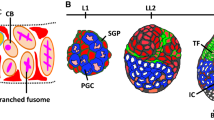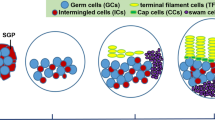Abstract
Tissue-specific adult stem cells are responsible for generating a range of various differentiated cells during their life time; these cells are intimately associated with niche for maintenance and function. Recent studies of germline stem cell niches in Drosophila gonad suggest that stem cells within a niche constantly compete with each other for niche occupancy. Competition within a niche occurs between same type of stem cells as well as different types. In both cases, cell adhesion molecules are critical in mediating the competition.


Similar content being viewed by others
References
Li, L., & Xie, T. (2005). Stem cell niche: structure and function. Annual Review of Cell and Developmental Biology, 21, 605–31.
Morrison, S. J., & Spradling, A. C. (2008). Stem cells and niches: mechanisms that promote stem cell maintenance throughout life. Cell, 132(4), 598–611.
Johnston, L. A. (2009). Competitive interactions between cells: death, growth, and geography. Science, 324(5935), 1679–82.
Moreno, E., Basler, K., & Morata, G. (2002). Cells compete for decapentaplegic survival factor to prevent apoptosis in Drosophila wing development. Nature, 416(6882), 755–9.
Xie, T., & Spradling, A. C. (2000). A niche maintaining germ line stem cells in the Drosophila ovary. Science, 290(5490), 328–30.
Margolis, J., & Spradling, A. (1995). Identification and behavior of epithelial stem cells in the Drosophila ovary. Development, 121(11), 3797–807.
Zhao, R., et al. (2008). Age-related changes of germline stem cell activity, niche signaling activity and egg production in Drosophila. Aging Cell, 7(3), 344–54.
Jin, Z., et al. (2008). Differentiation-defective stem cells outcompete normal stem cells for niche occupancy in the Drosophila ovary. Cell Stem Cell, 2(1), 39–49.
Song, X., et al. (2004). Bmp signals from niche cells directly repress transcription of a differentiation-promoting gene, bag of marbles, in germline stem cells in the Drosophila ovary. Development, 131(6), 1353–64.
Xie, T., & Spradling, A. C. (1998). decapentaplegic is essential for the maintenance and division of germline stem cells in the Drosophila ovary. Cell, 94(2), 251–60.
Chen, D., & McKearin, D. (2003). Dpp signaling silences bam transcription directly to establish asymmetric divisions of germline stem cells. Current Biology, 13(20), 1786–91.
Chen, D., & McKearin, D. M. (2003). A discrete transcriptional silencer in the bam gene determines asymmetric division of the Drosophila germline stem cell. Development, 130(6), 1159–70.
Lavoie, C. A., Ohlstein, B., & McKearin, D. M. (1999). Localization and function of Bam protein require the benign gonial cell neoplasm gene product. Developmental Biology, 212(2), 405–13.
Song, X., et al. (2002). Germline stem cells anchored by adherens junctions in the Drosophila ovary niches. Science, 296(5574), 1855–7.
Shen, R., et al. (2009). eIF4A controls germline stem cell self-renewal by directly inhibiting BAM function in the Drosophila ovary. Proceedings of the National Academy of Sciences of theUnited States of America, 106(28), 11623–8.
Yamashita, Y. M. (2008). Selfish stem cells compete with each other. Cell Stem Cell, 2(1), 3–4.
Brawley, C., & Matunis, E. (2004). Regeneration of male germline stem cells by spermatogonial dedifferentiation in vivo. Science, 304(5675), 1331–4.
Kai, T., & Spradling, A. (2004). Differentiating germ cells can revert into functional stem cells in Drosophila melanogaster ovaries. Nature, 428(6982), 564–9.
Sheng, X. R., Brawley, C. M., & Matunis, E. L. (2009). Dedifferentiating spermatogonia outcompete somatic stem cells for niche occupancy in the Drosophila testis. Cell Stem Cell, 5(2), 191–203.
Cheng, J., et al. (2008). Centrosome misorientation reduces stem cell division during ageing. Nature, 456(7222), 599–604.
Rhiner, C., et al. (2009). Persistent competition among stem cells and their daughters in the Drosophila ovary germline niche. Development, 136(6), 995–1006.
Moreno, E., & Basler, K. (2004). dMyc transforms cells into super-competitors. Cell, 117(1), 117–29.
Fuller, M. T. (1993). Spermatogenesis. In M. Bate & A. Martinez Arias (Eds.), The development of Drosophila (pp. 71–147). Cold Spring Harbor: Cold Spring Harbor Laboratory Press.
Kiger, A. A., et al. (2001). Stem cell self-renewal specified by JAK-STAT activation in response to a support cell cue. Science, 294(5551), 2542–5.
Leatherman, J. L., & Dinardo, S. (2008). Zfh-1 controls somatic stem cell self-renewal in the Drosophila testis and nonautonomously influences germline stem cell self-renewal. Cell Stem Cell, 3(1), 44–54.
Tulina, N., & Matunis, E. (2001). Control of stem cell self-renewal in Drosophila spermatogenesis by JAK-STAT signaling. Science, 294(5551), 2546–9.
Issigonis, M., et al. (2009). JAK-STAT signal inhibition regulates competition in the Drosophila testis stem cell niche. Science, 326(5949), 153–6.
Voog, J., D’Alterio, C., & Jones, D. L. (2008). Multipotent somatic stem cells contribute to the stem cell niche in the Drosophila testis. Nature, 454(7208), 1132–6.
Yamashita, Y. M., Jones, D. L., & Fuller, M. T. (2003). Orientation of asymmetric stem cell division by the APC tumor suppressor and centrosome. Science, 301(5639), 1547–50.
Tanentzapf, G., et al. (2007). Integrin-dependent anchoring of a stem-cell niche. Nature Cell Biology, 9(12), 1413–8.
Delon, I., & Brown, N. H. (2007). Integrins and the actin cytoskeleton. Current Opinion in Cell Biology, 19(1), 43–50.
Humphries, J. D., Byron, A., & Humphries, M. J. (2006). Integrin ligands at a glance. Journal of Cell Science, 119(Pt 19), 3901–3.
Hynes, R. O. (2002). Integrins: bidirectional, allosteric signaling machines. Cell, 110(6), 673–87.
Xi, R. (2009). Anchoring stem cells in the niche by cell adhesion molecules. Cell Adh Migr, 3(4), 396–401.
Takai, Y., et al. (2008). Nectins and nectin-like molecules: roles in contact inhibition of cell movement and proliferation. Nature Reviews Molecular Cell Biology, 9(8), 603–15.
Tran, J., Brenner, T. J., & DiNardo, S. (2000). Somatic control over the germline stem cell lineage during Drosophila spermatogenesis. Nature, 407(6805), 754–7.
Kiger, A. A., White-Cooper, H., & Fuller, M. T. (2000). Somatic support cells restrict germline stem cell self-renewal and promote differentiation. Nature, 407(6805), 750–4.
Callus, B. A., & Mathey-Prevot, B. (2002). SOCS36E, a novel Drosophila SOCS protein, suppresses JAK/STAT and EGF-R signalling in the imaginal wing disc. Oncogene, 21(31), 4812–21.
Bhattacharya, D., Ehrlich, L. I., & Weissman, I. L. (2008). Space-time considerations for hematopoietic stem cell transplantation. European Journal of Immunology, 38(8), 2060–7.
Czechowicz, A., et al. (2007). Efficient transplantation via antibody-based clearance of hematopoietic stem cell niches. Science, 318(5854), 1296–9.
Dick, J. E. (2008). Stem cell concepts renew cancer research. Blood, 112(13), 4793–807.
Warner, J. K., et al. (2004). Concepts of human leukemic development. Oncogene, 23(43), 7164–77.
Nilsson, L., et al. (2002). Involvement and functional impairment of the CD34(+)CD38(−)Thy-1(+) hematopoietic stem cell pool in myelodysplastic syndromes with trisomy 8. Blood, 100(1), 259–67.
Nilsson, L., et al. (2000). Isolation and characterization of hematopoietic progenitor/stem cells in 5q-deleted myelodysplastic syndromes: evidence for involvement at the hematopoietic stem cell level. Blood, 96(6), 2012–21.
Jamieson, C. H., et al. (2004). Granulocyte-macrophage progenitors as candidate leukemic stem cells in blast-crisis CML. New England Journal of Medicine, 351(7), 657–67.
Castor, A., et al. (2005). Distinct patterns of hematopoietic stem cell involvement in acute lymphoblastic leukemia. Natural Medicines, 11(6), 630–7.
Blanpain, C., & Fuchs, E. (2009). Epidermal homeostasis: a balancing act of stem cells in the skin. Nature Reviews Molecular Cell Biology, 10(3), 207–17.
Blanpain, C., et al. (2004). Self-renewal, multipotency, and the existence of two cell populations within an epithelial stem cell niche. Cell, 118(5), 635–48.
Nishimura, E. K., Granter, S. R., & Fisher, D. E. (2005). Mechanisms of hair graying: incomplete melanocyte stem cell maintenance in the niche. Science, 307(5710), 720–4.
Nishimura, E. K., et al. (2002). Dominant role of the niche in melanocyte stem-cell fate determination. Nature, 416(6883), 854–60.
Acknowledgements
We thank Erika Matunis and Valentina Greco for helpful discussions, anonymous reviewers and members of the Xi laboratory for helpful comments, Ning Yang for the illustrations, and Si Qi Wang for help with manuscript preparation. Research in our laboratory is supported by the Chinese Ministry of Science and Technology.
Author information
Authors and Affiliations
Corresponding author
Rights and permissions
About this article
Cite this article
Zhao, R., Xi, R. Stem Cell Competition for Niche Occupancy: Emerging Themes and Mechanisms. Stem Cell Rev and Rep 6, 345–350 (2010). https://doi.org/10.1007/s12015-010-9128-3
Published:
Issue Date:
DOI: https://doi.org/10.1007/s12015-010-9128-3




